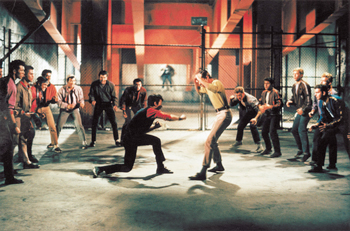by Daniel Hathaway

Mitchell’s role was crucial and tricky. Thanks to the way movies are made, vocal and orchestral tracks are recorded separately, making it an easy matter to nix the prerecorded orchestra but complicating things for the guy on the podium. It’s one thing to coordinate music between pit and stage in a Broadway musical and quite another to sync live musicians with the inexorable timing of a film. That’s where Mitchell’s video monitor came into play: a series of “streamers” (warnings of upcoming events) and “punches” (dots indicating precise moments of coordination) marched across his screen, superimposed on the movie, giving him both conductorial flexibility and the possibility of exactitude. It was fun to watch.

When the original stage version of the show opened at New York’s Winter Garden Theater in 1957, an orchestra of 31 players — large for Broadway — included 5 percussionists, guitarist, and a piano/celesta player. On Sunday, the Severance Hall stage was teeming with musicians, providing an opulent symphonic palette for Leonard Bernstein’s music.
Of course, there are some inevitable shortfalls involved in combining live music with a preformatted medium. The Cleveland Orchestra was the clear winner in sonic terms, the singing and dialogue sounding compressed and dull by comparison.
And the audience didn’t quite know how to react at first to events on the screen. You don’t normally applaud after a big production number in a movie theater, but eventually the crowd on Sunday allowed itself to imagine that singers and dancers were just as much a part of the experience as the Orchestra.
The management kept the lights down during the end titles, staving off the normal run for the exits and allowing the audience to enjoy retrospective music from the score. Brett Mitchell and The Cleveland Orchestra won a huge ovation at the end. After several bows, Mitchell responded by hoisting Bernstein’s score aloft for its own round of applause.
Published on ClevelandClassical.com June 6, 2017.
Click here for a printable copy of this article



